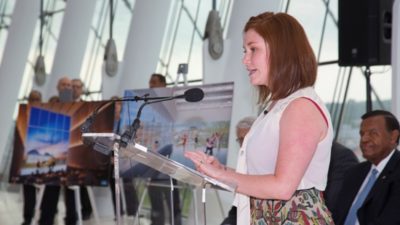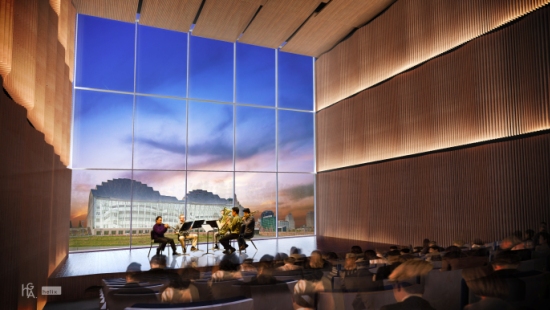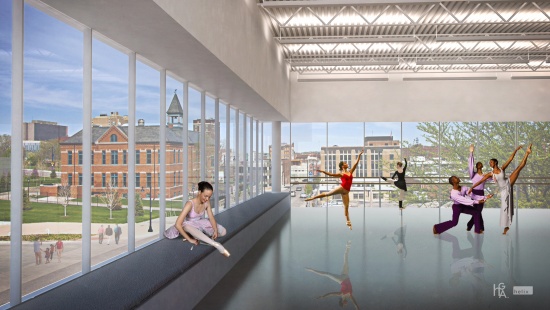Block just south of Kauffman Center set to become new location for Conservatory of Music and Dance
The proposed Downtown Campus for the Arts for the University of Missouri-Kansas City achieved another milestone today with the announcement of a real estate pledge setting up a new home for the university’s Conservatory of Music and Dance.
A group of anonymous donors, working with the Downtown Council, have assembled an 80,000-square-foot tract that can accommodate Phase I of the multi-phase project. The site covers a full city block bounded by Broadway, Central, 17th and 18th streets, directly south of the Kauffman Center for the Performing Arts.
The tract is being donated contingent on a successful campaign by UMKC to raise the full $96 million estimated cost for Phase I. The announcement marks the third milestone in the progress of the Downtown Campus, following the public release of detailed impact studies and the announcement months ago of a $20 million challenge grant pledge by the Muriel McBrien Kauffman Foundation.
The announcement took place in the Brandmeyer Great Hall of the Kauffman Center, in front of a giant wall of glass offering a direct line-of-sight view of the property.
“This is our dream site,” said UMKC Chancellor Leo E. Morton. “It offers everything we wanted, everything we hoped for, a perfect site to execute the vision we have for our students, and for this vibrant and growing artistic district in the heart of Kansas City.
“The Conservatory of Music and Dance has found a home here in the Crossroads District,” Morton said. “It is nothing short of exhilarating to stand here in this beautiful hall, the embodiment of a vision for artistic greatness, and look at the site of our future Conservatory mere footsteps away.”
Morton thanked the anonymous donors who arranged for the land purchase, referring to them as “a group of angels.” He also acknowledged the critical role played by Philip Kirk, past chairman of DST Realty, and the Downtown Council in organizing and coordinating the effort.
“This gift brings us another step closer to meeting the challenge put forth by Julia Irene Kauffman,” Morton said. “It is an important step, but there is still much work to be done.”
The Kaufman challenge grant of $20 million is contingent on raising the remaining money needed to complete Phase I of the project. The original $90 million estimate was for construction; the land just pledged is valued at $6 million, which raises the overall cost of the project, combining construction and land, to $96 million. The $20 million challenge grant, the $6 million land donation and another $1 million donated by several other donors brings the total raised so far to $27 million. UMKC hopes to raise a total of $48 million, to be matched by $48 million in state of Missouri funding, to complete the project. Today’s announcement means that UMKC has passed the halfway mark in raising the $48 million from private sources.
Michael Hagedorn, chair of the Downtown Council, offered special thanks to the four property owners who are selling tracts on the block to the non-profit development corporation set up to create the campus. They are:
- 1701 Broadway, owned by Dean Martin, Paulla Martin & Jim Martin; occupied by Griner and Schmitz Inc.
- 1711 Broadway, owned and operated by Guadalupe Centers, Inc.; Cris Medina, CEO and Jean-Paul Chaurand, COO
- 315 W. 17th St., owned by Mike & Mary McNiel; occupied by the McClelland Company
- 1711 Central St., owned by Steve, Lainie and Sara Wilbur and occupied by the J. Wilbur Company
“This is a moment of clarity and opportunity for the UMKC Conservatory, for Downtown and for America’s Creative Crossroads,” Hagedorn said. “Today’s announcement marks a significant step forward in the evolution of the creative crossroads, where artists, innovators, entrepreneurs and Conservatory students will collaborate within a livable, walkable and transit-connected urban center.”
Mayor Sly James said the latest milestone represents a “uniquely Kansas City” development.
“This truly demonstrates the power of synergy: diverse people and disparate elements coming together to benefit one great city, all happening where Kansas City’s great strengths in the arts and entrepreneurship come together, in the heart of the urban core,” James said.
Jane Chu, CEO of the Kauffman Center, said placing the conservatory next door to the Kauffman Center represents “the next step in the realization of a powerful vision: the exponential power of placing performance, teaching and learning in proximity.” She cited similar urban arts combinations such as the Juilliard School and Lincoln Center in New York as the model for what is happening in Kansas City.
Conservatory student Sarah Carney – calling the bright, glass-enclosed Kauffman Center “the greenhouse where our dreams take root” – said that proximity will educate students in ways that transcend classroom instruction.
“Future conservatory students will gain a new understanding of their true potential, in Kansas City’s thriving arts district. We will grow as the artists, educators and healers that we are destined to be,” Carney said.
Phase 1 of the expansive multi-decade plan – one of the “Big Five” civic priorities for the region identified by the Greater Kansas City Chamber of Commerce – involves moving the university’s renowned Conservatory of Music and Dance to a downtown location. Subsequent phases would move other university-based arts programs to the site.
The campus would address several highly significant needs and opportunities for both campus and community:
- the university’s need for increased space and improved facilities for its renowned visual and performing arts programs;
- the need for growth space on the landlocked Volker campus;
- the city’s need to boost employment, activity and residency in the urban core;
- and the wealth of opportunities for artistic and educational synergy, economic development and national attention being generated by the city’s burgeoning arts and cultural renaissance.
An economic impact study by the Mid-America Regional Council (MARC) estimates that the economic activity associated with the construction of the arts campus and reuse of the Volker campus would average, at minimum, approximately 409 jobs, $30.8 million in real GDP, and $22.9 million in real disposable personal income per year over 25 years. Of these impacts, a little over half results from the construction itself, with the rest generated by the expansion of arts and other educational programs at UMKC.
The concept is based on successful performing arts school/performing arts center combinations such as Juilliard/Lincoln Center in New York, and the New England Conservatory/Jordan Hall in Boston. The concept of a Downtown Arts Campus clearly supports UMKC’s mission and strategic goals to “advance urban engagement” and “excel in the visual and performing arts”; addresses the 2005 “Time To Get It Right” report goal to “enhance UMKC’s stature as one of the top 20 universities in the arts;” and provides an opportunity to create innovative state-of-the-art educational and living facilities downtown for arts students.



